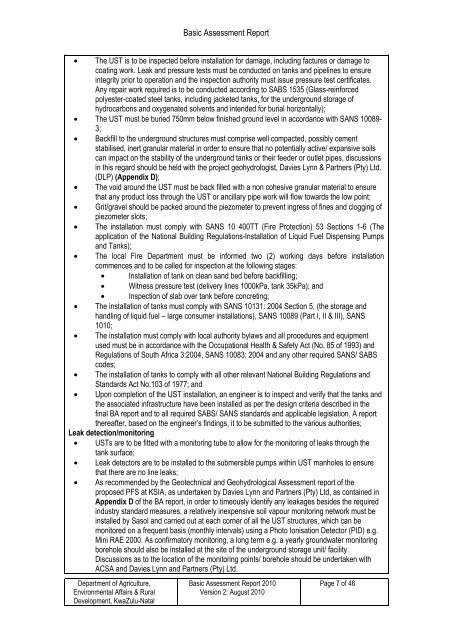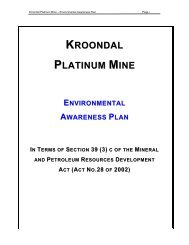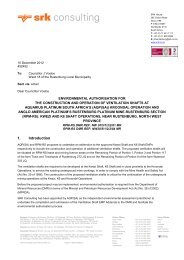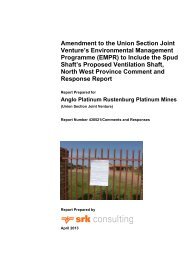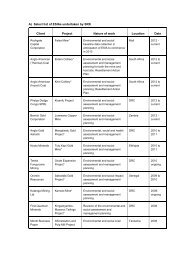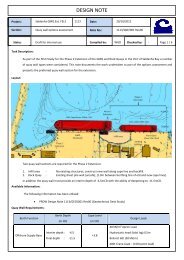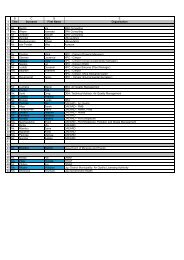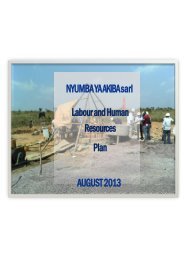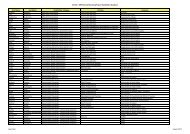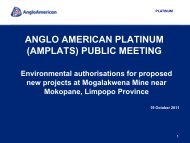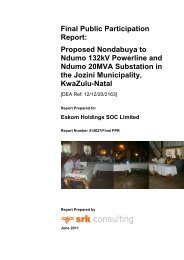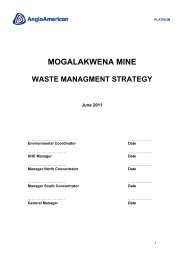Basic Assessment Report - SRK
Basic Assessment Report - SRK
Basic Assessment Report - SRK
You also want an ePaper? Increase the reach of your titles
YUMPU automatically turns print PDFs into web optimized ePapers that Google loves.
<strong>Basic</strong> <strong>Assessment</strong> <strong>Report</strong>• The UST is to be inspected before installation for damage, including factures or damage tocoating work. Leak and pressure tests must be conducted on tanks and pipelines to ensureintegrity prior to operation and the inspection authority must issue pressure test certificates.Any repair work required is to be conducted according to SABS 1535 (Glass-reinforcedpolyester-coated steel tanks, including jacketed tanks, for the underground storage ofhydrocarbons and oxygenated solvents and intended for burial horizontally);• The UST must be buried 750mm below finished ground level in accordance with SANS 10089-3;• Backfill to the underground structures must comprise well compacted, possibly cementstabilised, inert granular material in order to ensure that no potentially active/ expansive soilscan impact on the stability of the underground tanks or their feeder or outlet pipes, discussionsin this regard should be held with the project geohydrologist, Davies Lynn & Partners (Pty) Ltd.(DLP) (Appendix D);• The void around the UST must be back filled with a non cohesive granular material to ensurethat any product loss through the UST or ancillary pipe work will flow towards the low point;• Grit/gravel should be packed around the piezometer to prevent ingress of fines and clogging ofpiezometer slots;• The installation must comply with SANS 10 400TT (Fire Protection) 53 Sections 1-6 (Theapplication of the National Building Regulations-Installation of Liquid Fuel Dispensing Pumpsand Tanks);• The local Fire Department must be informed two (2) working days before installationcommences and to be called for inspection at the following stages:• Installation of tank on clean sand bed before backfilling;• Witness pressure test (delivery lines 1000kPa, tank 35kPa); and• Inspection of slab over tank before concreting;• The installation of tanks must comply with SANS 10131: 2004 Section 5, (the storage andhandling of liquid fuel – large consumer installations), SANS 10089 (Part I, II & III), SANS1010;• The installation must comply with local authority bylaws and all procedures and equipmentused must be in accordance with the Occupational Health & Safety Act (No. 85 of 1993) andRegulations of South Africa 3:2004, SANS 10083: 2004 and any other required SANS/ SABScodes;• The installation of tanks to comply with all other relevant National Building Regulations andStandards Act No.103 of 1977; and• Upon completion of the UST installation, an engineer is to inspect and verify that the tanks andthe associated infrastructure have been installed as per the design criteria described in thefinal BA report and to all required SABS/ SANS standards and applicable legislation. A reportthereafter, based on the engineer’s findings, it to be submitted to the various authorities;Leak detection/monitoring• USTs are to be fitted with a monitoring tube to allow for the monitoring of leaks through thetank surface;• Leak detectors are to be installed to the submersible pumps within UST manholes to ensurethat there are no line leaks;• As recommended by the Geotechnical and Geohydrological <strong>Assessment</strong> report of theproposed PFS at KSIA, as undertaken by Davies Lynn and Partners (Pty) Ltd, as contained inAppendix D of the BA report, in order to timeously identify any leakages besides the requiredindustry standard measures, a relatively inexpensive soil vapour monitoring network must beinstalled by Sasol and carried out at each corner of all the UST structures, which can bemonitored on a frequent basis (monthly intervals) using a Photo Ionisation Detector (PID) e.g.Mini RAE 2000. As confirmatory monitoring, a long term e.g. a yearly groundwater monitoringborehole should also be installed at the site of the underground storage unit/ facility.Discussions as to the location of the monitoring points/ borehole should be undertaken withACSA and Davies Lynn and Partners (Pty) Ltd.Department of Agriculture,Environmental Affairs & RuralDevelopment, KwaZulu-Natal<strong>Basic</strong> <strong>Assessment</strong> <strong>Report</strong> 2010Version 2: August 2010Page 7 of 46


